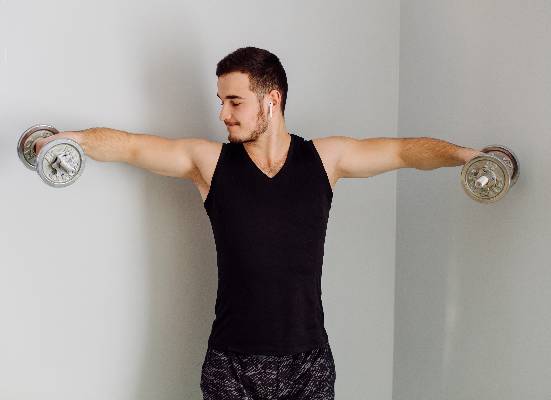Over Head Military Press Exercise To Work Out The Shoulders
Introduction to the Overhead Military Press Exercise
When it comes to building strong, defined shoulders, few exercises pack as much punch as the overhead military press. This classic strength training move not only targets your deltoids but also engages your triceps and upper chest, making it a powerhouse addition to any workout routine. Whether you’re a seasoned gym-goer or just starting out on your fitness journey, mastering this exercise can elevate your shoulder game to new heights. So grab that barbell or set of dumbbells and prepare to sculpt those shoulders like never before!
Benefits of Including the Overhead Military Press in Your Workout
The Overhead Military Press is a powerhouse move for building shoulder strength. It targets the deltoids, giving you that broad-shouldered look many aspire to achieve.
Incorporating this exercise into your routine enhances overall upper body stability. Strong shoulders contribute significantly to performance in various sports and daily activities.
Additionally, it engages your core muscles as you stabilize during the lift. This helps improve posture and can alleviate back pain over time.
Not only does it promote muscle growth, but it also boosts functional strength. Everyday tasks like lifting objects or pushing furniture become easier with stronger shoulders.
Adding variety to your workouts keeps things interesting and challenging. The Overhead Military Press is an effective way to mix up your regimen while reaping multiple benefits at once.
Proper Form and Technique for Performing the Exercise
To perform the Overhead Military Press exercise correctly, start by standing tall with your feet shoulder-width apart. This stable stance provides a solid foundation for lifting.
Grip the barbell or dumbbells firmly at shoulder height, palms facing forward. Your elbows should be just below your wrists to maintain safety and control throughout the movement.
As you begin to press upward, engage your core muscles. This stability is crucial in preventing injury while maximizing strength gains.
Lift the weights directly overhead without arching your back excessively. Keep a straight line from wrists to shoulders as you extend fully at the top of each rep.
Lower the weights carefully back to shoulder level. Maintain focus on controlling both ascent and descent for optimal engagement of your shoulder muscles and joints.
Variations of the Overhead Military Press for Different Fitness Levels
For those new to the Over Head Military Press exercise, starting with seated variations can provide stability. This helps in mastering form before progressing to standing lifts.
As strength improves, consider using dumbbells instead of a barbell. Dumbbells allow for a more natural range of motion and help address muscle imbalances.
Advanced lifters might explore the push press or jerk variations. These involve leg drive, increasing weights significantly while engaging core muscles throughout the movement.
If looking for an extra challenge, try single-arm presses. They build unilateral strength and enhance coordination by forcing your body to stabilize itself during each lift.
Mix these variations into your routine to keep workouts fresh and cater them to your fitness level. Each variation offers unique benefits that contribute to shoulder development and overall upper body strength.
Tips for Maximizing Results from the Overhead Military Press
To maximize results from the Overhead Military Press, start with a proper warm-up. Engage your shoulders and arms to prepare them for heavier lifts.
Focus on progressive overload. Gradually increase weights as your strength improves. This keeps muscles challenged and promotes growth.
Incorporate different rep ranges in your routine. Mixing low-rep strength sets with higher-rep endurance sets can enhance muscle development effectively.
Pay attention to recovery as well. Allow adequate rest between workouts targeting the shoulders to prevent overtraining and support muscle repair.
Consider incorporating unilateral variations, like single-arm presses. This helps improve balance and prevents muscular imbalances that can arise from bilateral lifting.
Pair this exercise with complementary movements such as rows or push-ups. These will help develop overall shoulder stability and strength while enhancing performance in the Overhead Military Press itself.
Common Mistakes to Avoid When Doing the Overhead Military Press
One of the most common mistakes in the overhead military press is using too much weight. This often leads to poor form and potential injury. Start with a manageable load to master your technique first.
Another mistake is failing to engage the core. A strong core stabilizes your body, allowing for better control during the lift. Weakening this area can lead to excessive back arching.
Many lifters also neglect their grip. An improper grip width can affect balance and power output, so ensure you find what feels right for you.
Don’t forget about breathing. Holding your breath throughout the movement reduces oxygen flow and can cause dizziness or fatigue mid-set. Focus on exhaling when pushing up and inhaling as you lower weights down smoothly.
Possible Risks and Precautions When Performing the Exercise
The Overhead Military Press is an effective exercise, but it’s not without risks. Improper form can lead to shoulder injuries or strains. Always pay attention to your body’s signals.
Start with lighter weights until you master the technique. This helps prevent overexertion and reduces the risk of injury.
Warming up before starting is crucial. Dynamic stretches targeting the shoulders prepare them for the workout ahead. Neglecting this step may result in stiffness or discomfort.
Consider using a spotter, especially when lifting heavier weights. They can provide support and help maintain proper form throughout the movement.
If you have pre-existing conditions like rotator cuff issues or chronic pain, consult a healthcare professional before attempting this exercise. Listening to your body will always guide you toward safer practices while working out.
Incorporating the Overhead Military
Including the Overhead Military Press in your workout routine can significantly enhance your shoulder strength and overall upper body development. To integrate this exercise effectively, consider scheduling it as part of your shoulder day or upper body split. It pairs well with exercises like lateral raises and bench presses to create a comprehensive shoulder workout.
Start with lighter weights to master the proper form before progressing to heavier loads. Aim for 3-4 sets of 8-12 repetitions for optimal results, adjusting depending on your fitness level. As you become more comfortable, you may explore different variations such as using dumbbells or performing seated presses.
Don’t forget about recovery—allow adequate rest between sessions targeting the shoulders to prevent overtraining. Tracking your progress will help keep you motivated and ensure you’re continuously challenging yourself.
By incorporating the overhead military press into your regimen and following best practices, you’ll be well on your way to achieving stronger shoulders and improved athletic performance.
- About the Author
- Latest Posts
Johnnie D. Jackow Sr., the founder and CEO of Total Body Fitness, Worldwide, has a long-standing career in the fitness industry. He began as a certified personal trainer in the mid-90s and soon after authored his first weight loss book in 1998. This led to the launch of Total Body Fitness, Nationwide in the USA at the same time. Johnnie gained recognition as the fitness guru of his time, running infomercials on local TV late at night in Houston, Texas. Over the years, he has helped more than 40,000 individuals from all over the world achieve their health and fitness goals. With over 60,000 hours of documented training in integrative functional medicine, he completed his PhD in human physiology in 2010. His primary objective is to assist people in reaching their health and fitness goals through alternative approaches rather than relying solely on conventional medicine and pharmaceutical drugs. Today, with almost three decades of experience under his belt, Johnnie continues to be a leader in health and fitness.








